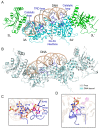Structural Basis of DNMT1 and DNMT3A-Mediated DNA Methylation
- PMID: 30544982
- PMCID: PMC6316889
- DOI: 10.3390/genes9120620
Structural Basis of DNMT1 and DNMT3A-Mediated DNA Methylation
Abstract
DNA methylation, one of the major epigenetic mechanisms, plays critical roles in regulating gene expression, genomic stability and cell lineage commitment. The establishment and maintenance of DNA methylation in mammals is achieved by two groups of DNA methyltransferases (DNMTs): DNMT3A and DNMT3B, which are responsible for installing DNA methylation patterns during gametogenesis and early embryogenesis, and DNMT1, which is essential for propagating DNA methylation patterns during replication. Both groups of DNMTs are multi-domain proteins, containing a large N-terminal regulatory region in addition to the C-terminal methyltransferase domain. Recent structure-function investigations of the individual domains or large fragments of DNMT1 and DNMT3A have revealed the molecular basis for their substrate recognition and specificity, intramolecular domain-domain interactions, as well as their crosstalk with other epigenetic mechanisms. These studies highlight a multifaceted regulation for both DNMT1 and DNMT3A/3B, which is essential for the precise establishment and maintenance of lineage-specific DNA methylation patterns in cells. This review summarizes current understanding of the structure and mechanism of DNMT1 and DNMT3A-mediated DNA methylation, with emphasis on the functional cooperation between the methyltransferase and regulatory domains.
Keywords: DNA methyltransferase; DNMT1; DNMT3A; allosteric regulation; autoinhibition; de novo DNA methylation; maintenance DNA methylation.
Conflict of interest statement
The authors declare no conflict of interest.
Figures









Similar articles
-
Interactions within the mammalian DNA methyltransferase family.BMC Mol Biol. 2003 May 30;4:7. doi: 10.1186/1471-2199-4-7. Epub 2003 May 30. BMC Mol Biol. 2003. PMID: 12777184 Free PMC article.
-
DNMT1, DNMT3A and DNMT3B proteins are differently expressed in mouse oocytes and early embryos.J Mol Histol. 2017 Dec;48(5-6):417-426. doi: 10.1007/s10735-017-9739-y. Epub 2017 Oct 13. J Mol Histol. 2017. PMID: 29027601
-
Domain Structure of the Dnmt1, Dnmt3a, and Dnmt3b DNA Methyltransferases.Adv Exp Med Biol. 2016;945:63-86. doi: 10.1007/978-3-319-43624-1_4. Adv Exp Med Biol. 2016. PMID: 27826835 Review.
-
Domain Structure of the Dnmt1, Dnmt3a, and Dnmt3b DNA Methyltransferases.Adv Exp Med Biol. 2022;1389:45-68. doi: 10.1007/978-3-031-11454-0_3. Adv Exp Med Biol. 2022. PMID: 36350506 Free PMC article.
-
Tissue-specific roles of de novo DNA methyltransferases.Epigenetics Chromatin. 2025 Jan 17;18(1):5. doi: 10.1186/s13072-024-00566-2. Epigenetics Chromatin. 2025. PMID: 39819598 Free PMC article. Review.
Cited by
-
Emerging role of different DNA methyltransferases in the pathogenesis of cancer.Front Pharmacol. 2022 Aug 25;13:958146. doi: 10.3389/fphar.2022.958146. eCollection 2022. Front Pharmacol. 2022. PMID: 36091786 Free PMC article. Review.
-
Modulating epigenetic modifications for cancer therapy (Review).Oncol Rep. 2023 Mar;49(3):59. doi: 10.3892/or.2023.8496. Epub 2023 Feb 17. Oncol Rep. 2023. PMID: 36799181 Free PMC article. Review.
-
Editorial-Role of DNA Methyltransferases in the Epigenome.Genes (Basel). 2019 Jul 30;10(8):574. doi: 10.3390/genes10080574. Genes (Basel). 2019. PMID: 31366147 Free PMC article.
-
Epigenomic and enhancer dysregulation in uterine leiomyomas.Hum Reprod Update. 2022 Jun 30;28(4):518-547. doi: 10.1093/humupd/dmac008. Hum Reprod Update. 2022. PMID: 35199155 Free PMC article. Review.
-
LRF Promotes Indirectly Advantageous Chromatin Conformation via BGLT3-lncRNA Expression and Switch from Fetal to Adult Hemoglobin.Int J Mol Sci. 2022 Jun 24;23(13):7025. doi: 10.3390/ijms23137025. Int J Mol Sci. 2022. PMID: 35806029 Free PMC article.

